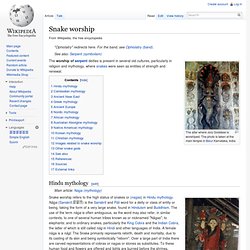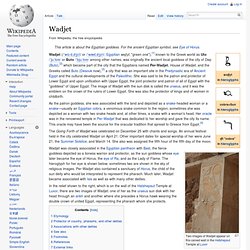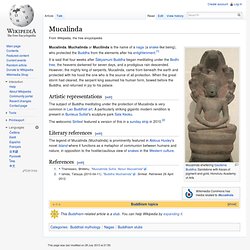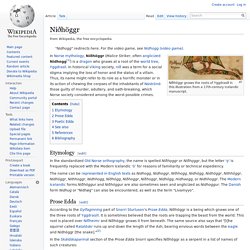

Ophiolatreia. Sacred Texts Misc Texts Ophiolatreia The Rites and mysteries connected with the origin, rise, and development of serpent worship in various parts of the world, enriched with interesting traditions, and a full description of the celebrated serpent mounds & temples, the whole forming an exposition of one of the phases of phallic, or sex worship.

(Anonymous) Title PageChapter 1Chapter 2Chapter 3Chapter 4Chapter 5Chapter 6Chapter 7Chapter 8Chapter 9Chapter 10Chapter 11. Jesus Our Serpent. Sermon delivered February 1, 2003 by Pastor Donald J.

Gettys McDonald Road Seventh-day Adventist Church McDonald, Tennessee Biblical quotations are from the New International Version NIV unless otherwise noted. Snakes in mythology. The serpent, or snake, is one of the oldest and most widespread mythological symbols.

The word is derived from Latin serpens, a crawling animal or snake. Snakes have been associated with some of the oldest rituals known to humankind[1] and represent dual expression[2] of good and evil.[3] In some cultures snakes were fertility symbols, for example the Hopi people of North America performed an annual snake dance to celebrate the union of Snake Youth (a Sky spirit) and Snake Girl (an Underworld spirit) and to renew fertility of Nature. During the dance, live snakes were handled and at the end of the dance the snakes were released into the fields to guarantee good crops.
Snake worship. The altar where Jory Goddess is worshiped.

The photo is taken at the main temple in Belur Karnataka, India Hindu mythology[edit] Horned Serpent. A Horned Serpent in a Barrier Canyon Style pictograph, Western San Rafael Swell region of Utah.

The Horned Serpent appears in the mythologies of many Native Americans.[1] Details vary among tribes, with many of the stories associating the mystical figure with water, rain, lightning and/or thunder. Horned Serpents were major components of the Southeastern Ceremonial Complex of North American prehistory.[2][3] Horned serpents also appear in European and Near Eastern mythology. In Native American cultures[edit] Rock art depicting a Horned Serpent, at Pony Hills and Cook's Peak, New Mexico Horned serpents appear in the oral history of numerous Native American cultures, especially in the Southeastern Woodlands and Great Lakes.
Muscogee Creek traditions include a Horned Serpent and a Tie-Snake, estakwvnayv in the Muscogee Creek language. Yuchi people made effigies of the Horned Serpent as recently as 1905. Among Cherokee people, a Horned Serpent is called an uktena. Wadjet. Two images of Wadjet appear on this carved wall in the Hatshepsut Temple at Luxor Wadjet (/ˈwɑːdˌdʒɛt/ or /ˈwædˌdʒɛt/; Egyptian wꜣḏyt, "green one"),[1] known to the Greek world as Uto /ˈjuːtoʊ/ or Buto /ˈbjuːtoʊ/ among other names, was originally the ancient local goddess of the city of Dep (Buto),[2] which became part of the city that the Egyptians named Per-Wadjet, House of Wadjet, and the Greeks called Buto (Desouk now),[3] a city that was an important site in the Predynastic era of Ancient Egypt and the cultural developments of the Paleolithic.

She was said to be the patron and protector of Lower Egypt and upon unification with Upper Egypt, the joint protector and patron of all of Egypt with the "goddess" of Upper Egypt. The image of Wadjet with the sun disk is called the uraeus, and it was the emblem on the crown of the rulers of Lower Egypt. Ophion. Sources[edit] Pherecydes of Syros's Heptamychia is the first attested mention of Ophion.

The story was apparently popular in Orphic poetry, of which only fragments survive. Apollonius of Rhodes in his Argonautica (1.495f) summarizes a song of Orpheus: Lycophron (1191) relates that Zeus' mother, that is Rhea, is skilled in wrestling, having cast the former queen Eurynome into Tartarus. Nonnus in his Dionysiaca has Hera say (8.158f): Harmonia here is probably an error in the text for Eurynome.
Beside the oracular wall she saw the first tablet, old as the infinite past, containing all the things in one: upon it was all that Ophion lord paramount had done, all that ancient Cronus accomplished. Mucalinda. Mucalinda sheltering Gautama Buddha; Sandstone with traces of pigment and gold, Honolulu Academy of Arts It is said that four weeks after Śākyamuni Buddha began meditating under the Bodhi tree, the heavens darkened for seven days, and a prodigious rain descended.

However, the mighty king of serpents, Mucalinda, came from beneath the earth and protected with his hood the one who is the source of all protection. When the great storm had cleared, the serpent king assumed his human form, bowed before the Buddha, and returned in joy to his palace. Níðhöggr. Níðhöggr gnaws the roots of Yggdrasill in this illustration from a 17th-century Icelandic manuscript.

In Norse mythology, Níðhöggr (Malice Striker, often anglicized Nidhogg[1]) is a dragon who gnaws at a root of the world tree, Yggdrasil. In historical Viking society, níð was a term for a social stigma implying the loss of honor and the status of a villain. Leviathan. Leviathan (/lɨˈvaɪ.əθən/; Hebrew: לִוְיָתָן, Modern Livyatan Tiberian Liwyāṯān ; "twisted, coiled") is a sea monster referenced in the Tanakh, or the Old Testament.

The word has become synonymous with any large sea monster or creature. In literature (e.g., Herman Melville's Moby-Dick) it refers to great whales, and in Modern Hebrew, it simply means "whale". It is described extensively in Job 41 and mentioned in Isaiah 27:1. Tanakh[edit] The Leviathan is mentioned six times in the Tanakh, with Job 41:1–34 being dedicated to describing him in detail:[1] 1 Can you pull in the leviathan with a fishhook or tie down his tongue with a rope? 2 Can you put a cord through his nose or pierce his jaw with a hook? 3 Will he keep begging you for mercy? 4 Will he make an agreement with you for you to take him as your slave for life? 5 Can you make a pet of him like a bird or put him on a leash for your girls?
6 Will traders barter for him? 10 No-one is fierce enough to rouse him. Christianity[edit] Chaos (cosmogony) Nehushtan. Moses lifts up the brass snake, curing the Israelites of snakebites. Hezekiah called the snake Nehushtan. King Hezekiah (reigned 715/716 – 687 BCE) instituted a religious iconoclastic reform and destroyed "the brazen serpent that Moses had made; for unto those days the children of Israel did offer to it; and it was called Nehushtan.
" (2 Kings 18:4) The tradition of naming it Nehushtan is no older than the time of Hezekiah.[1] Serpent image[edit] Illuyanka. The Sky God kills the dragon Illuyanka. Behind him his son Sarruma. Ladon (mythology) Heracles and Ladon, Roman relief plate, late era. Diodorus Siculus gives an euhemerist interpretation of Ladon, as a human shepherd guarding a flock of golden-fleeced sheep, adding "But with regards to such matters it will be every man’s privilege to form such opinions as accord with his own belief".[6] Serpent (symbolism) Serpent (Bible) In the Hebrew Bible, the Book of Genesis refers to the serpent who was partly responsible for the Fall of Man (Gen 3:1-20). Serpent is also used to describe sea monsters. Examples of these identifications are in the Book of Isaiah where a reference is made to a serpent-like Leviathan (Isaiah 27:1), and in the Book of Amos where a serpent resides at the bottom of the sea (Amos 9:3).
Serpent figuratively describes biblical places such as Egypt (Jer 46:22), and the city of Dan (Gen 49:17).